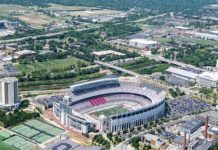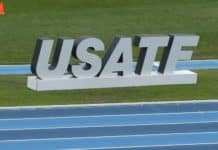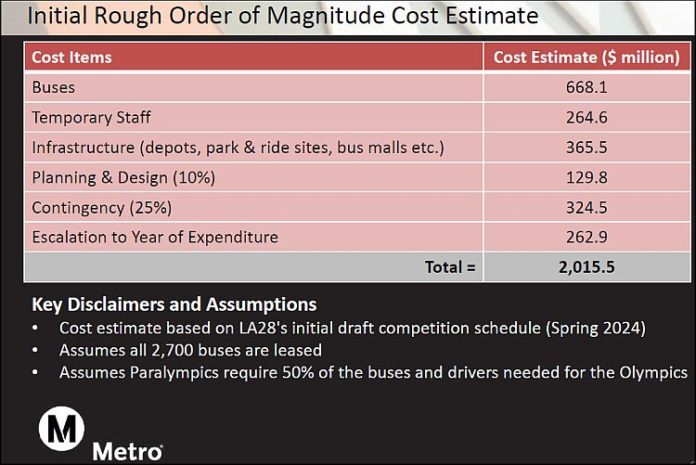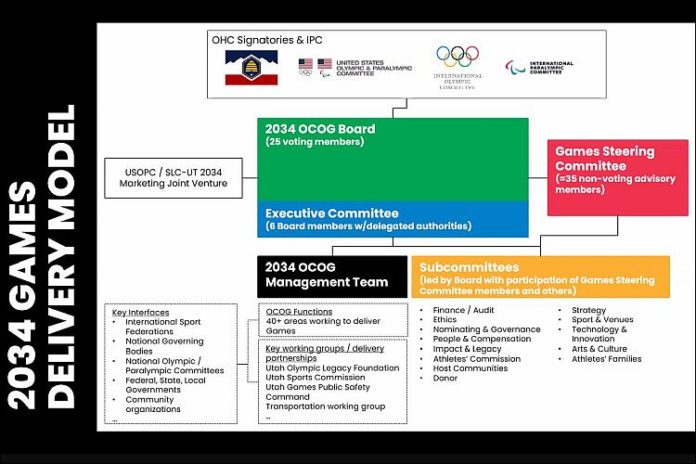★ The Sports Examiner: Chronicling the key competitive, economic and political forces shaping elite sport and the Olympic Movement.★
★ To get the daily Sports Examiner Recap by e-mail: sign up here! ★
≡ A $2.015 BILLION QUESTION ≡
“Building upon the precedent set in the Games Agreements between LA28 and venue cities, where LA28 commits to reimbursing for increased municipal services, Metro is pursuing a reimbursement agreement for the Games Enhanced Transit Service (GETS).
“This additional service represents a financial burden for Metro that would not otherwise be needed if not for the 2028 Games. This agreement will be part of the MOU that is executed between Metro and LA28.”
That’s the final paragraph in a five-page update on the Los Angeles Metropolitan Transportation Authority’s effort to create a “Games Enhanced Transit Service” to specifically address its estimate of public transportation needs it will be required to address for the 2028 Olympic and Paralympic Games.
At issue is an estimated 10,500-staff, 2,700-bus, $2.015.5 billion program to haul spectators and LA28 volunteers to the Olympic and Paralympic venues.
It’s part of the agenda of a 14 May (Wednesday) meeting of Metro’s Ad Hoc 2028 Olympic & Paralympic Games Committee, chaired by Los Angeles County Supervisor Janice Hahn with Los Angeles Mayor Karen Bass as Vice Chair (all referenced documents can be accessed from the above link).
The update explains the project – Games Enhanced Transit Service – as including:
● 105 days of operations, from assembly to removal
● 10,500 people: 6,000 bus drivers + 4,500 operations staff
● 2,700 buses; 18 agencies already in support as loaners
● 15 new staging depots and 13 bus staging areas
● 25 park-and-ride sites
Funding has been requested by Metro, working with the LA28 organizers and officials from other local transit agencies:
● “Metro has requested $3.2 billion in the President’s Fiscal Year 2026 Federal Budget which is expected to be released in late May of 2025″
● Toll revenue from Interstate 10 and 110 Freeways
● Incremental revenue from advertising on buses, a “Games transit pass” and an add-on fee to each ticket sold, currently moving through the California Legislature as Assembly Bill 1237.
The easiest solution for Metro would be Federal funding, but the agency did not get any Federal help during the Biden Administration, despite multiple requests. What it will get from the Trump Administration is apparently soon to be known for Fiscal Year 2026, that begins on 1 October 2025.
The Metro ask to the Department of Transportation is for $3.2 billion, but the specified cost – so far – for the Games Enhanced Transit Service is $2.015.5 billion, identified as an “Initial Rough Order of Magnitude Cost”:
● $668.1 million: buses
● $365.5 million: infrastructure
● $264.6 million: staff
● $129.8 million: planning and design (10%)
● $324.5 million: contingency (25%)
● $262.9 million: inflation to year of expenditure (3%)
There is also the “Games Route Network” of 210 highway miles and 100 surface miles over which priority – via signage and street painting – will be reserved for Olympic Family and Metro’s own Games-related uses.
To support the planning and design effort, the committee also includes a recommendation to award a four-year, $42,043,610 contract to the mammoth Mott MacDonald Group, a London-based management, engineering, and development consultancy with a Los Angeles office and significant, successful experiences with Metro. It beat out two other proposers to be the recommended contractor; it’s team includes 27 sub-contractors.
The Metro presentation on the contract explained that by hiring out significant parts of the planning, it “ensures Metro can remain responsive to shifting priorities while maintaining focus on delivering key transportation solutions in time for the Games.”
¶
The Metro Ad Hoc Committee agenda also includes a portion of the $3.2 billion request to the Trump Administration for support, which includes the Games Enhanced Transit Service and other items. A partial list was offered in a presentation:
● $2.015.5 billion: Games Enhanced Transit Service
● $210.9 million: Games Route Network (dedicated lanes)
● $216.0 million: Key Stations (9 locations)
● $130.3 million: Integrated Transit Management (combine two centers)
● $115.6 million: Transportation Demand Management (fare system)
● $101.7 million: First/Last Mile Improvements (4 locations)
● $80.0 million: Light Rail Improvements (5 locations)
● $80.0 million: Metro Mobility Hubs (4-8 locations)
● $41.0 million: Bus Priority Improvements (12 miles)
This is $2.991 billion, short of the $3.20 billion request, but most of it. The Games Enhanced Transit Service and Games Route Network items appear to be targeted at the 2028 Games, but the actual need for the other items vs. long-term improvement opportunities would require more detail.
The committee agenda also includes a motion to work with local jurisdictions to establish “fan zones” for the 2028 Games that are near existing transit stops, and a potential water taxi service between San Pedro and Long Beach during and after the 2028 Games.
¶
Observed: This appears to be the first time that Metro documents have publicly stated that funding for any excess services provided by the agency related to the 2028 Olympic and Paralympic Games should be paid for by the LA28 organizers.
That’s not possible, and questions will be raised once the fate of the request for $3.2 billion in support from the U.S. Department of Transportation for Fiscal Year 2026 is known, possibly by the end of this month.
Quoting Chief Engineer Montgomery Scott (James Doohan) to Dr. Gillian Taylor (Catherine Hicks) in 1986’s Star Trek IV: The Voyage Home: “Hold on tight, lassie. It gets bumpy from here.”
Next up is Wednesday’s meeting of the Metro Ad Hoc 2028 Olympic & Paralympic Games Committee.
¶
★ Receive our exclusive, weekday TSX Recap by e-mail by clicking here.
★ Sign up a friend to receive the TSX Recap by clicking here.
★ Please consider a donation here to keep this site going.
For our updated, 694-event International Sports Calendar for 2025 and beyond, by date and by sport, click here!


























